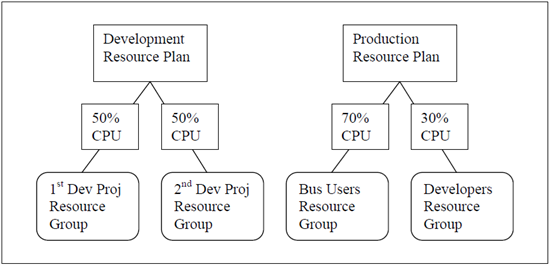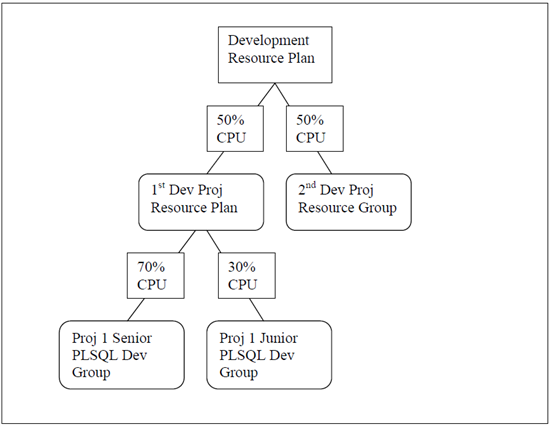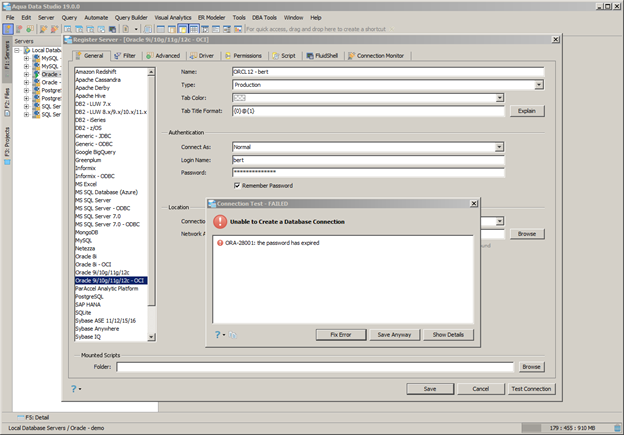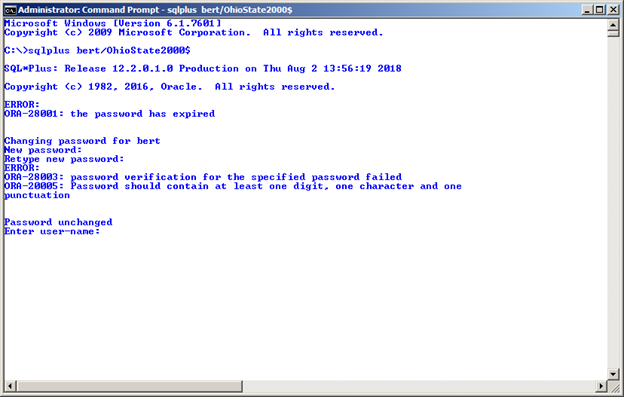Database security is a hot topic these days, especially with all the new and seemingly never ending security compliance requirements being imposed such as GDPR. This means that DBAs must up their game when it comes to database security.
Some DBAs may think these new requirements apply only to production, but depending on the situation DBAs may well need to apply tauter security across the board – including development and all test databases (e.g. unit testing, stress testing, and acceptance testing).
This blog covers some very simple database security checks which are easy to deploy and which at least start you on the road to better security. While the examples shown are for Oracle, the security concepts and thus techniques should apply equally well across all other database platforms. You may just need to translate the concepts and example scripts shown here to your specific database platform.
Note that for many examples I will be using the powerful, multi-database GUI tool: Aqua Data Studio.
Each week I will post four simple, yet worthwhile database security ideas. Part one, posted last week, covered the first four security ideas. This blog now picks up with the next set of four security ideas.
Issue #5 – Limit Access To Special Logins
Part one covered the misuse of built-in accounts (SYS and SYSTEM), connection types (as SYSDBA), and built-in roles (CONNECT, RESOURCE, and DBA). Non-Oracle examples for built-in accounts include SA for SQL Server and Sybase, ROOT for MySQL, DB2ADMIN for IBM DB2 LUW, and POSTGRES for PostgreSQL.
Part one also recommended creating your own roles and logins based upon your security requirements rather than just using the built-in logins. Moreover, no matter the database platform, you also can grant far too many or overly powerful privileges to your own DBA type logins. The one consistent problem across all these issues is how many people have access to whatever DBA accounts you do use.
A friend who is the DBA director of a SQL Server shop is enduring a security compliance audit, and the first major hurdle he ran into was the proliferation of access to special logins. They had allowed every developer, manager and even some non-technical people access to the SA login. It was more than just for convenience, they had no other privileged login accounts and so they all shared the one in order to perform any database operation.
While he readily agreed that it was a very poor practice and would cause their audit to fail, this habit is too deeply embedded in the way they function and cannot be changed anytime soon. The first step will be to create a new DBA login with all the same rights as SA and then slowly to remove privileges from that account until the correct minimum viable grants are discovered. Then they will work on reducing the number of people with access, possibly creating a second DBA type login with the same privileges and slowly removing grants from that account.
The key point is that this friend’s shop will not legitimately pass their security audit in the near future. You may not see nor agree with the critical importance of this issue, even if your shop does not follow this bad practice. But the security experts have identified this as not only a bad practice, but one that seemingly is pervasive in many small to mid-sized companies' IT departments – especially those which do not have full-time DBAs, but rather let application development architects or team leads manage their databases.
Issue #6 – Implement Automated Resource Controls
This next recommendation probably has the least real security-related value, but it’s worth mentioning nonetheless since it builds on what we’ve discussed so far (i.e. profiles), and also leads to the next topic which will be much more clearly security oriented. Other than possibly helping to prevent or minimize the effects of certain Denial of Service (DOS) type attacks against your database, it’s really more of a fair resource utilization control technique. Note too that there are no simple SQL commands per se (at least with Oracle) for managing this.
Ever have some database users that you need to limit in terms of fair resource consumption, but with more granularity than a mechanism like Oracle profiles? Think about those users who love to kick off Cartesian join queries or fetch multi-million-row queries back to their PC on a regular basis.
These guys are being unfair resource hogs, and simple, user-friendly tools like Aqua Data Studio may make it easy for users to ask for expensive operations without realizing it. Thus it would be easy for one user’s action to have a negative impact on another user in terms of time to run without either party knowing why the slowdown occurs.
Another way to say this is that just as desktop PCs have increased in their speed and thus capabilities, so too have their users’ demands grown against the database servers they access. So sometimes we need to rein in certain Aqua Data Studio users (or users of any tool for that matter) lest they run amok.
So let’s look at Oracle Resource Groups. Suppose we have two development projects sharing a common database server and they can’t afford one group to consume an unfair percentage of the shared servers’ resources to the detriment of the other group. Furthermore, suppose that on the production database server business users must be allocated the majority of the resources. Figure 1 highlights these two scenarios of potentially desired resource limitation objectives.

Figure 1: Example of Desired Resource Limits
Three other aspects make Oracle’s resource management a worthwhile feature.
First, you can create hierarchies of plans. Thus we can take the development resource plan and delve into more details on how we want it to function for different classes of users. We can define that senior developers on dev project #1 should get slightly more resources than junior developers as shown in Figure 2. Whereas dev project #2 remains the same with everyone getting the same resource limits.
Figure 2: Example of a Multi-level Resource Control
Let’s now return to the idea of a DOS (Denial Of Service) security attack. Suppose that someone makes such an attack using a username and password for a junior level developer from dev project #1; the resource limits will prevent that attack from consuming more than 15% of the server’s resources (i.e. 30% of 50%). That might make the difference between a slow machine that needs a reboot and being able to work on it in spite of such attacks.
And second, you can define resource consumption limits within a group that automatically cause the users’ processes to switch from one resource group to another. Thus in the example above, we could define dev project #1’s senior developers resource group such that any process that consumes more than some maximum threshold downgrades to a junior status job – and thus gets far less CPU time for that point forward.
Finally, almost everything you could do above with Profiles you can do much better with Resource Plans and Groups. For example, both execution and idle time limits can be best managed via this technique – and with additional options and features.
Unfortunately, you’ll need to learn some overly-complex PL/SQL package like shown below to implement the development resource controls shown in Figure 2.
begin
sys.dbms_resource_manager.clear_pending_area
sys.dbms_resource_manager.create_pending_area
sys.dbms_resource_manager.create_consumer_group (
consumer_group => 'PROJ_1_SENIOR_DEV'
,comment => 'Group for senior database developers on project #1.'
,mgmt_mth => 'ROUND-ROBIN'
,category => 'INTERACTIVE');
sys.dbms_resource_manager.submit_pending_area
end;
/
begin
sys.dbms_resource_manager.clear_pending_area
sys.dbms_resource_manager.create_pending_area
sys.dbms_resource_manager_privs.grant_switch_consumer_group (
grantee_name => 'PROJ_1_DEV_1'
,consumer_group => 'PROJ_1_SENIOR_DEV'
,grant_option => FALSE);
sys.dbms_resource_manager.submit_pending_area
end;
/
begin
sys.dbms_resource_manager.clear_pending_area
sys.dbms_resource_manager.create_pending_area
sys.dbms_resource_manager.create_consumer_group (
consumer_group => 'PROJ_1_JUNIOR_DEV'
,comment => 'Group for junior database developers on project #1.'
,mgmt_mth => 'ROUND-ROBIN'
,category => 'INTERACTIVE');
sys.dbms_resource_manager.submit_pending_area
end;
/
begin
sys.dbms_resource_manager.clear_pending_area
sys.dbms_resource_manager.create_pending_area
sys.dbms_resource_manager_privs.grant_switch_consumer_group (
grantee_name => 'PROJ_1_DEV_2'
,consumer_group => 'PROJ_1_JUNIOR_DEV'
,grant_option => FALSE);
sys.dbms_resource_manager.submit_pending_area
end;
/
begin
sys.dbms_resource_manager.clear_pending_area
sys.dbms_resource_manager.create_pending_area
sys.dbms_resource_manager.create_consumer_group (
consumer_group => 'PROJ_2_ALL_DEV'
,comment => 'Group for all database developers on project #2.'
,mgmt_mth => 'ROUND-ROBIN'
,category => 'INTERACTIVE');
sys.dbms_resource_manager.submit_pending_area
end;
/
begin
sys.dbms_resource_manager.clear_pending_area
sys.dbms_resource_manager.create_pending_area
sys.dbms_resource_manager_privs.grant_switch_consumer_group (
grantee_name => 'PROJ_2_DEV_2'
,consumer_group => 'PROJ_2_ALL_DEV'
,grant_option => FALSE);
sys.dbms_resource_manager.submit_pending_area
end;
/
begin
sys.dbms_resource_manager.clear_pending_area
sys.dbms_resource_manager.create_pending_area
sys.dbms_resource_manager_privs.grant_switch_consumer_group (
grantee_name => 'PROJ_2_DEV_1'
,consumer_group => 'PROJ_2_ALL_DEV'
,grant_option => FALSE);
sys.dbms_resource_manager.submit_pending_area
end;
/
begin
sys.dbms_resource_manager.clear_pending_area
sys.dbms_resource_manager.create_pending_area
sys.dbms_resource_manager.create_plan (
plan => 'PROJ_1'
,mgmt_mth => 'EMPHASIS'
,active_sess_pool_mth => 'ACTIVE_SESS_POOL_ABSOLUTE'
,parallel_degree_limit_mth => 'PARALLEL_DEGREE_LIMIT_ABSOLUTE'
,queueing_mth => 'FIFO_TIMEOUT'
,comment => null
,sub_plan => FALSE);
sys.dbms_resource_manager.create_plan_directive (
plan => 'PROJ_1'
,group_or_subplan => 'OTHER_GROUPS'
,switch_estimate => FALSE
,switch_for_call => FALSE
,comment => NULL );
sys.dbms_resource_manager.create_consumer_group (
consumer_group => 'PROJ_1_SENIOR_DEV'
,comment => 'Group for senior database developers on project #1.');
sys.dbms_resource_manager.create_plan_directive (
plan => 'PROJ_1'
,group_or_subplan => 'PROJ_1_SENIOR_DEV'
,switch_estimate => FALSE
,max_idle_time => 60
,mgmt_p1 => 1
,switch_for_call => FALSE
,utilization_limit => 70
,comment => NULL );
sys.dbms_resource_manager.create_consumer_group (
consumer_group => 'PROJ_1_JUNIOR_DEV'
,comment => 'Group for junior database developers on project #1.');
sys.dbms_resource_manager.create_plan_directive (
plan => 'PROJ_1'
,group_or_subplan => 'PROJ_1_JUNIOR_DEV'
,switch_estimate => FALSE
,max_idle_time => 60
,mgmt_p1 => 1
,switch_for_call => FALSE
,utilization_limit => 30
,comment => NULL );
sys.dbms_resource_manager.submit_pending_area
end;
/
begin
sys.dbms_resource_manager.clear_pending_area
sys.dbms_resource_manager.create_pending_area
sys.dbms_resource_manager.create_plan (
plan => 'PROJ_2'
,mgmt_mth => 'EMPHASIS'
,active_sess_pool_mth => 'ACTIVE_SESS_POOL_ABSOLUTE'
,parallel_degree_limit_mth => 'PARALLEL_DEGREE_LIMIT_ABSOLUTE'
,queueing_mth => 'FIFO_TIMEOUT'
,comment => null
,sub_plan => FALSE);
sys.dbms_resource_manager.create_plan_directive (
plan => 'PROJ_2'
,group_or_subplan => 'OTHER_GROUPS'
,switch_estimate => FALSE
,switch_for_call => FALSE
,comment => NULL );
sys.dbms_resource_manager.create_consumer_group (
consumer_group => 'PROJ_2_ALL_DEV'
,comment => 'Group for all database developers on project #2.');
sys.dbms_resource_manager.create_plan_directive (
plan => 'PROJ_2'
,group_or_subplan => 'PROJ_2_ALL_DEV'
,switch_estimate => FALSE
,max_idle_time => 60
,switch_for_call => FALSE
,utilization_limit => 100
,comment => NULL );
sys.dbms_resource_manager.submit_pending_area
end;
/
begin
sys.dbms_resource_manager.clear_pending_area
sys.dbms_resource_manager.create_pending_area
sys.dbms_resource_manager.create_plan (
plan => 'DEV_PLAN'
,mgmt_mth => 'RATIO'
,active_sess_pool_mth => 'ACTIVE_SESS_POOL_ABSOLUTE'
,parallel_degree_limit_mth => 'PARALLEL_DEGREE_LIMIT_ABSOLUTE'
,queueing_mth => 'FIFO_TIMEOUT'
,comment => null
,sub_plan => FALSE);
sys.dbms_resource_manager.create_plan_directive (
plan => 'DEV_PLAN'
,group_or_subplan => 'OTHER_GROUPS'
,switch_estimate => FALSE
,switch_for_call => FALSE
,comment => NULL );
sys.dbms_resource_manager.create_consumer_group (
consumer_group => 'PROJ_1_SENIOR_DEV'
,comment => 'Group for senior database developers on project #1.');
sys.dbms_resource_manager.create_plan_directive (
plan => 'DEV_PLAN'
,group_or_subplan => 'PROJ_1_SENIOR_DEV'
,switch_estimate => FALSE
,switch_for_call => FALSE
,utilization_limit => 35
,comment => NULL );
sys.dbms_resource_manager.create_consumer_group (
consumer_group => 'PROJ_1_JUNIOR_DEV'
,comment => 'Group for junior database developers on project #1.');
sys.dbms_resource_manager.create_plan_directive (
plan => 'DEV_PLAN'
,group_or_subplan => 'PROJ_1_JUNIOR_DEV'
,switch_estimate => FALSE
,switch_for_call => FALSE
,utilization_limit => 15
,comment => NULL );
sys.dbms_resource_manager.create_consumer_group (
consumer_group => 'PROJ_2_ALL_DEV'
,comment => 'Group for all database developers on project #2.');
sys.dbms_resource_manager.create_plan_directive (
plan => 'DEV_PLAN'
,group_or_subplan => 'PROJ_2_ALL_DEV'
,switch_estimate => FALSE
,switch_for_call => FALSE
,utilization_limit => 50
,comment => NULL );
sys.dbms_resource_manager.submit_pending_area
end;
/
Issue #7 – Don’t Permit Tools Saving Passwords
This security recommendation will probably incur the 2nd most negative user opposition (much like the prior issues about using Oracle profiles or resource groups to timeout idle sessions). Aqua Data Studio is a great productivity enhancer, and so it’s not uncommon for people to choose to “save their passwords” such that the connection screen takes but a quick look and a double-click in order to connect to one’s databases. That’s exactly why it’s unsafe because anyone finding an unattended PC with Aqua Data Studio installed and using saved passwords could possibly have unfettered access to all of your databases which have saved passwords. This actually happens more than you think, hence why the idle session timeout is a great first defense. Better yet, if your desktop tools permit it, turn off (preferably centrally rather than per desktop) the ability to save passwords. That combined with idle timeouts would be far better security-wise, even though people would complain about having to retype their passwords all the time. In fact, if your database tools allow connecting to the database through MS Active Directory (AD) or LDAP managed logins, then this issue is entirely eliminated. That may be the safest bet.
Issue #8 – Use Password Aging and Complexity Verification
Let’s assume that you are using passwords and even not permitting them to be saved by desktop tools; you still have one more password-related security step to consider implementing. Many people hold the following premise to be true: all passwords, no matter how good, have a short “shelf-life” (i.e. are safe only for a short duration of time) and thus should be changed regularly. I’ve worked at government sites where we had to change the password every 30 days. Yes, I hated it – but it was a requirement to work there since we dealt with sensitive data.
Thus the next recommendation sure to generate some hate mail: database passwords should forcibly be required to change at regular intervals with additional logic specifying the required complexity, plus any disallowed selections (e.g. cannot use old passwords a second time). Following such advice will help to mitigate the security risks in those shops that choose not to disable password saving by limiting the window of opportunity to use stolen passwords. Plus like many earlier security recommendations, this one too is best achieved via the Oracle database itself.
Here’s an example of a very basic password verification PL/SQL function (of course you can use as your basis either this one or the Oracle-provided default contained in the script):
$ORACLE_HOME/RDBMS/admin/utlpwdmg.sql):
CREATE OR REPLACE FUNCTION verify_password
(username VARCHAR2,
new_password VARCHAR2,
old_password VARCHAR2)
RETURN BOOLEAN
IS
i INTEGER;
c CHAR;
isdigit BOOLEAN := false;
isletter BOOLEAN := false;
ispunct BOOLEAN := false;
differ INTEGER;
m INTEGER;
BEGIN
–Check if the password is same as the username
IF (new_password = username) THEN
raise_application_error(-20001, 'New password same as username');
END IF;
–Check for the new password = old password
IF (new_password = old_password) THEN
raise_application_error(-20002, 'New password same as old password');
END IF;
–Check for the minimum length of the password
IF length(new_password) < 8 THEN
raise_application_error(-20003, 'New password length less than 8 chars');
END IF;
–Check if the password is too common or simple
IF NLS_LOWER(new_password) IN ('welcome', 'database', 'account', 'user',
'password', 'oracle', 'computer', 'abcd','mgr', 'manager', 'tiger')
THEN raise_application_error(-20004, 'New password too common or simple');
END IF;
–Check if the password contains at least one
–letter, one digit, and one punctuation mark
FOR i IN 1 .. length(new_password) LOOP
c := substr(new_password,i,1);
IF (NOT isdigit) THEN
isdigit := (INSTR('0123456789',c) > 0);
END IF;
IF (NOT isletter) THEN
isletter := (INSTR
'abcdefghijklmnopqrstuvwxyzABCDEFGHIJKLMNOPQRSTUVWXYZ',c)
> 0);
END IF;
IF (NOT ispunct) THEN
ispunct := (INSTR('!"#$%&()''*+,-/:;<=>?_',c) > 0);
END IF;
EXIT WHEN isdigit AND isletter AND ispunct;
END LOOP;
IF (NOT isletter) OR (NOT isdigit) OR (NOT ispunct) THEN
raise_application_error(-20005, 'Password should contain at least one digit, one character and one punctuation');
END IF;
–Check if the password differs from the previous password by at least 3 letters
differ := length(old_password) – length(new_password);
IF abs(differ) < 3 THEN
IF length(new_password) < length(old_password) THEN
m := length(new_password);
ELSE
m:= length(old_password);
END IF;
differ := abs(differ);
FOR i IN 1..m LOOP
IF substr(new_password,i,1) != substr(old_password,i,1) THEN
differ := differ + 1;
END IF;
END LOOP;
IF differ < 3 THEN
raise_application_error(-20006, 'Password should differ by at least 3 characters');
END IF;
END IF;
–Everything is fine; return TRUE ;
RETURN(TRUE);
END;
/
Note – The password verify function must be owned by SYS.
Then to enact this password security verification plus all of the above mentioned additional password security checks, one simply uses Oracle profiles as follows:
ALTER PROFILE AQUA_DATA_STUDIO_DEV_SENIOR
LIMIT
SESSIONS_PER_USER 8
IDLE_TIME 60
FAILED_LOGIN_ATTEMPTS 3
PASSWORD_LIFE_TIME 30
PASSWORD_REUSE_TIME 365
PASSWORD_REUSE_MAX 1
PASSWORD_GRACE_TIME 1
PASSWORD_VERIFY_FUNCTION verify_password
Thus if a user tries to log into Aqua Data Studio and their password has expired, they will be prompted to replace it as shown below:
And if the user provides a new Oracle password that fails verification, an error like the one below will display:
Until next week when then, when we will delve even deeper into basic security techniques to harden your databases against attack.


